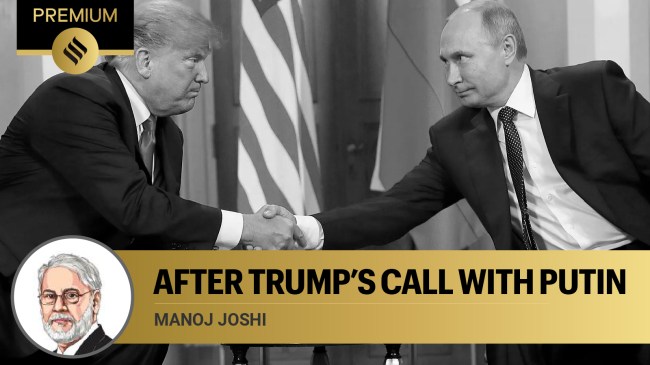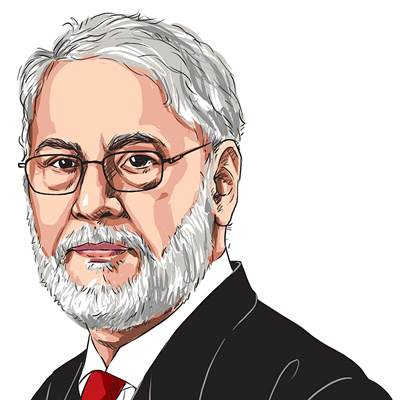Opinion After Trump’s call with Putin, there are openings for peace
Biden had not spoken to Putin for nearly three years because he saw the latter’s actions as those of a war criminal.
 US President Donald Trump with Russian President Vladimir Putin. (AP/File)
US President Donald Trump with Russian President Vladimir Putin. (AP/File) Almost three years since the Russian invasion of Ukraine in February 2022, prospects for peace have emerged following a phone call between US President Donald Trump and Russian President Vladimir Putin. Trump said that negotiations to end the war would begin “immediately” after the “lengthy and highly productive” phone call. He even expressed optimism about reaching a peace agreement. But even while advocating negotiations, the author of The Art of the Deal seems to have sacrificed leverage by revealing the American position.
Just before the call, in Brussels, his Defence Secretary, Pete Hegseth, laid out the American contours of the deal. He told a meeting of NATO allies that a return to Ukraine’s pre-2014 borders — before Russia annexed Crimea — was unrealistic, and that the US did not see Ukraine’s membership of NATO as part of the solution. Hegseth added that US troops would not be part of any post-war security presence in Ukraine.
Major obstacles exist in working out a peace agreement. The biggest, perhaps, is the need for territorial concessions by Ukraine and its need for credible security guarantees to guard against future Russian aggression. Russia currently occupies about a fifth of the country and has demanded that Kyiv cede the territory in a future settlement and become a permanently neutral country thereafter. Ukraine, on the other hand, seeks a Russian withdrawal from all its territory and a membership of NATO to guarantee its security. Twice in recent days, President Volodymyr Zelenskyy has said he is willing to negotiate with Putin if Western allies offer security guarantees as part of the settlement.
All this is a distinct shift in the tone of the conversation between the US and Russia. Note that former president Joe Biden had not spoken to the Russian president in nearly three years because he saw the latter’s actions as those of a war criminal. The war is currently more or less at a stalemate. For more than a year now, the battlefield advantage has been with Russia, though it has lost more troops compared to Ukraine. Just how serious the manpower issue is for Moscow is evident from the North Korean troops fighting for Russia, along with an assortment of other foreigners, including some from India.
NATO’s support for Ukraine in the last three years has been less than stellar. Aid came through bilateral channels, not NATO’s coordination. Equipment has come in penny-packets and logistical challenges have hindered the quick delivery of ammunition and spare parts. The alliance was itself poorly prepared for a full scale war in Europe and its own stocks of equipment and ammunition were depleted. Even the Biden administration provided aid in bits and pieces, and sometimes grudgingly, keeping in mind the dangers of escalation. There have been internal differences on any move to offer Kyiv accession into NATO. The US, Germany, Spain and Belgium have made their hesitation on that account clear.
The Ukrainians worry that if Russia is given control of the economically and militarily important Donbas region, it could adversely affect their ability to defend themselves in the future. In any case, Kyiv has seen Moscow break the post-Cold War security guarantees offered by the Budapest Memorandum and forcibly occupy Ukrainian territory. As for Russia, it retains a grudge against NATO for breaking its oral commitment not to expand eastwards.
Viewed in balance, there may be some value in the current American strategy. A “no-NATO” concession may persuade the Russians to come to the negotiating table. As for Ukraine, note that the Americans have not, as of now, said that all the territory captured since 2014 would become part of Russia. There is room for negotiation here.
But the Americans have made the alternatives clear to their own allies who want to fire their guns off the shoulders of the Ukrainians. The US may continue to supply weapons to Ukraine as part of a separate “minerals for weapons” deal, but it’s clear that it will not be a security guarantor. That leaves the Europeans holding the can. Under any deal, this is an opportunity for the European Union which must work out a way of leading its own military revival as a precondition for any kind of security guarantee for Ukraine. They have already taken some first steps, like ramping up munitions production, but they need to do much more.
The writer is a Distinguished Fellow, Observer Research Foundation, New Delhi




